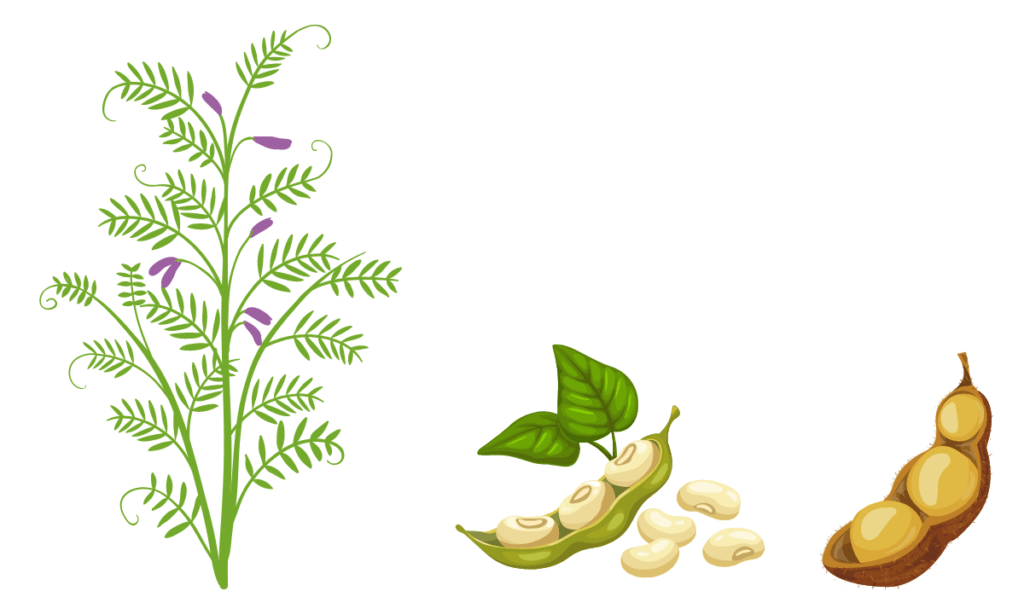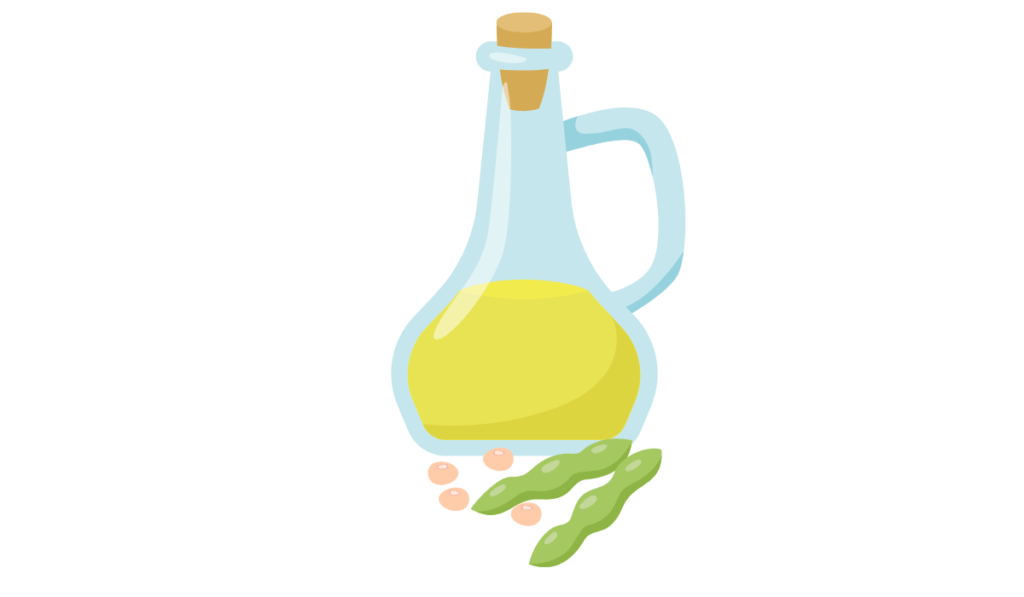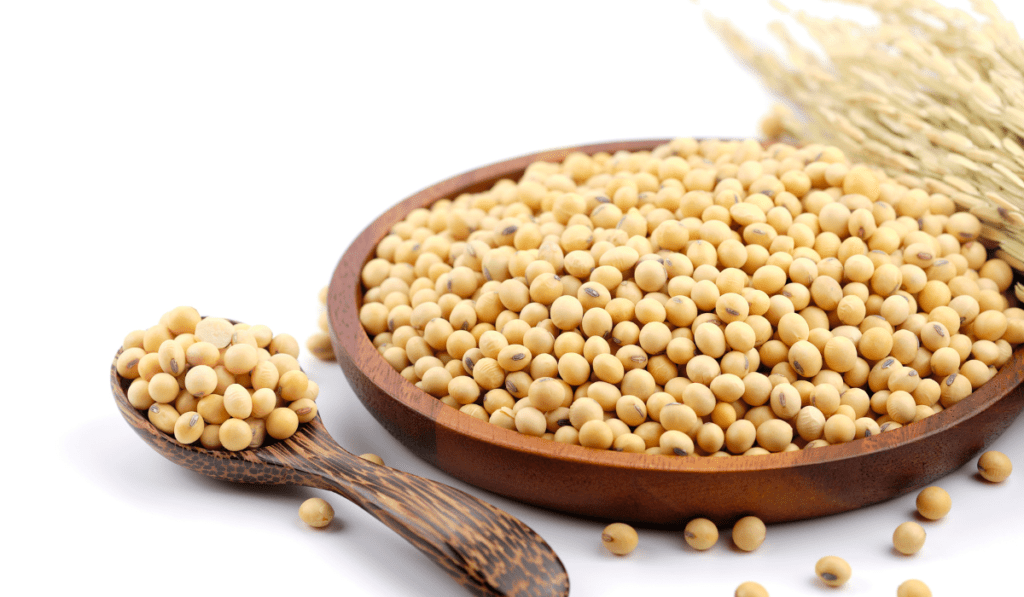Welcome to “The Ultimate Guide to Soybeans: Cultivation, Uses, and Global Trade.” This comprehensive guide is meticulously crafted to unfold every aspect of soybeans – a crop that’s not just a dietary staple but a cornerstone in global agriculture and trade.
In a world where sustainable farming and nutrition are increasingly paramount, understanding the role of soybeans becomes essential. This guide serves as your one-stop resource, whether you’re a farmer, a student, a nutritionist, or simply someone interested in the far-reaching impact of this versatile crop.
What You’ll Discover:
➡Chapter 1: Cultivation of Soybeans
➡Chapter 2: Pest and Disease Management in Soybean Cultivation
➡Chapter 3: The Role of Soybeans in Cuisine and Their Nutritional Profile
➡Chapter 4: Industrial and Non-Food Uses of Soybeans
➡Chapter 5: Global Trade and Economics of Soybeans
➡Chapter 6: Geographical Considerations in Soybean Cultivation
➡Chapter 7: The Future of Soybeans
Section 1: Cultivation of Soybeans

Soybeans, scientifically known as Glycine max, are a globally significant crop, revered for their versatility and nutritional value. In this section, we delve into the critical aspects of soybean cultivation, offering a detailed guide for both novice and experienced farmers. From selecting the ideal soil to understanding the nuances of seasonal planting, this guide aims to equip you with all the necessary knowledge for a successful soybean harvest.
Planting Soybeans
- Best Soil Types and Climate Conditions: Soybeans thrive in well-drained, fertile soils with a pH range of 6.0 to 6.8. They require a moderate climate, with temperatures between 55°F and 60°F to germinate and a growing season that provides warm, sunny days. Soybeans are sensitive to frost, making it crucial to time planting after the last expected frost date.
- Seasonal Considerations and Sowing Techniques: Optimal planting times vary by region. In general, planting should occur when the soil temperature reaches about 55°F. Seeds should be planted at a depth of 1 to 1.5 inches, spaced approximately 2.5 to 3 inches apart, in rows 15 to 30 inches apart. This spacing ensures adequate sunlight and air circulation, vital for growth.
Growing and Caring for Soybeans
- Watering, Fertilizing, and Managing Growth: Soybeans need about 20 to 30 inches of water during the growing season, with critical stages like pod development and seed filling requiring more water. Fertilization should be based on soil tests; generally, soybeans benefit from added nitrogen-fixing bacteria. Regular weeding is crucial, as soybeans compete poorly with weeds.
- Common Challenges in Soybean Cultivation: Farmers often face challenges like soybean cyst nematode, fungal diseases, and insect pests. Rotating crops and choosing resistant varieties can help manage these issues. Timely interventions with suitable organic or chemical treatments are crucial to prevent significant yield loss.
Harvesting Soybeans
- Signs of Maturity and Harvesting Techniques: Soybeans are ready for harvest when 95% of the pods have reached a tan or brown color, and the moisture content of the seeds is around 13-15%. Combine harvesters are commonly used for efficient harvesting. The process should be timely to minimize losses from shattering pods or weather damage.
- Post-harvest Handling and Storage: Post-harvest, soybeans should be dried to a moisture content of 10% to prevent mold and spoilage. They should be stored in a cool, dry place, free from pests. Proper storage ensures the quality of the soybeans for market or processing.
Cultivating soybeans can be a rewarding endeavor, given the right knowledge and tools. By understanding the soil and climate needs, mastering planting techniques, and managing growth challenges, farmers can optimize their soybean yield. Harvesting and storage practices further ensure that the quality of the produce is maintained, making soybeans a lucrative and sustainable crop choice.
Section 2: Pest and Disease Management in Soybean Cultivation

Effective pest and disease management is crucial for the health and productivity of soybean crops. This section provides comprehensive insights into identifying, preventing, and controlling common soybean pests and diseases. It also emphasizes sustainable practices, ensuring long-term crop health and environmental protection.
Common Pests and Diseases
- Identification and Prevention:
- Pests: Common soybean pests include soybean aphids, bean leaf beetles, and spider mites. Regular crop monitoring is essential for early detection.
- Diseases: Soybeans are susceptible to diseases like Sudden Death Syndrome (SDS), Phytophthora Root Rot, and Soybean Rust. Preventive measures include crop rotation, resistant varieties, and proper field sanitation.
- Organic and Chemical Control Methods:
- Organic Controls: These include biological control agents like beneficial insects or natural predators, and organic pesticides derived from natural sources. Cultural practices, such as crop rotation and maintaining plant residue, also play a significant role.
- Chemical Controls: When necessary, chemical pesticides can be used. However, they should be applied judiciously, following integrated pest management (IPM) strategies to minimize environmental impact and pesticide resistance.
Integrated Pest Management (IPM) Strategies
- Sustainable Practices in Pest and Disease Control:
- Monitoring and Identification: Regular field scouting and accurate pest and disease identification are the cornerstones of IPM.
- Threshold-Based Interventions: Chemical interventions are used only when pests or disease levels exceed economic thresholds, thus reducing unnecessary pesticide use.
- Combination of Practices: IPM involves a combination of biological, cultural, mechanical, and chemical practices for a holistic approach to pest and disease management.
Managing pests and diseases in soybean cultivation requires a balanced approach that protects the crop and the environment. Through vigilant monitoring, the use of resistant varieties, sustainable practices, and targeted interventions, farmers can effectively control pests and diseases, ensuring a healthy and productive soybean crop.
Section 3: The Role of Soybeans in Cuisine and Their Nutritional Profile

Soybeans play a pivotal role in global cuisine, renowned for their versatility and nutritional benefits. This section explores the nutritional aspects of soybeans, their health implications, and their diverse culinary uses, offering a window into the world of soy-based dishes and products.
Nutritional Value
- Detailed Breakdown of Nutrients in Soybeans:
- Protein: Soybeans are an excellent source of high-quality protein, making them a staple in vegetarian and vegan diets.
- Vitamins and Minerals: Rich in vitamins B, C, and E, soybeans also provide essential minerals like iron, calcium, and magnesium.
- Fiber and Fats: They contain significant amounts of dietary fiber and healthy fats, including omega-3 fatty acids.
- Health Benefits and Dietary Considerations:
- Heart Health and Cholesterol: Regular consumption of soybeans can contribute to heart health and lower bad cholesterol levels.
- Bone Health: The calcium and magnesium in soybeans support bone health.
- Allergies and Sensitivities: While soybeans offer numerous health benefits, they are also a common allergen. People with soy allergies should avoid soy-based products.
Nutritional Value table
Here’s a table outlining the nutritional value of soybeans. This table typically reflects the nutrient content per 100 grams of boiled soybeans:
| Nutrient | Amount in 100g of Boiled Soybeans | % Daily Value* |
|---|---|---|
| Calories | 173 kcal | 8.7% |
| Protein | 16.6 g | 33.2% |
| Total Fat | 9.0 g | 13.8% |
| – Saturated Fat | 1.3 g | 6.5% |
| – Monounsaturated Fat | 1.98 g | – |
| – Polyunsaturated Fat | 5.06 g | – |
| Carbohydrates | 9.9 g | 3.3% |
| – Dietary Fiber | 6.0 g | 24% |
| – Sugars | 3.0 g | – |
| Vitamins and Minerals | ||
| – Vitamin C | 1.7 mg | 2.8% |
| – Vitamin B6 | 0.1 mg | 5% |
| – Folate (B9) | 63 µg | 15.8% |
| – Calcium | 102 mg | 10.2% |
| – Iron | 5.1 mg | 63.8% |
| – Magnesium | 86 mg | 21.5% |
| – Phosphorus | 245 mg | 24.5% |
| – Potassium | 515 mg | 11% |
| – Zinc | 1.15 mg | 7.7% |
*% Daily Values are based on a 2,000 calorie diet. Your daily values may be higher or lower depending on your calorie needs.
Notes:
- Omega-3 and Omega-6 Fats: Soybeans are also a good source of essential fatty acids, particularly alpha-linolenic acid (omega-3) and linoleic acid (omega-6).
- Isoflavones: Soybeans contain isoflavones, a type of phytoestrogen, which have been studied for various health benefits.
- Cholesterol and Sodium: Soybeans are naturally cholesterol-free and low in sodium, making them a heart-healthy choice.
- Protein Quality: Soy protein is considered a complete protein, containing all nine essential amino acids in adequate quantities for human health.
This nutritional profile demonstrates why soybeans are celebrated for their health benefits and versatility in various diets. They are particularly important in vegetarian and vegan diets as a high-quality protein source.
Culinary Uses
- Preparing and Cooking Soybeans:
- Basic Preparation: Soybeans can be consumed boiled, roasted, or as part of various dishes. Soaking dried soybeans overnight reduces cooking time.
- Versatility: They can be processed into various forms like tofu, tempeh, soy milk, and soy flour, each suitable for different culinary applications.
- Recipes for Soy-Based Dishes and Products:
- Traditional Dishes: From Asian stir-fries with tofu to the Brazilian feijoada, soybeans adapt to various cuisines.
- Modern Adaptations: Soy-based meat substitutes, smoothies, and protein bars showcase the modern culinary versatility of soybeans.
Soybeans are a powerhouse of nutrition and culinary diversity. Understanding their health benefits and learning to incorporate them into daily cooking can lead to a healthier lifestyle. Whether you’re a professional chef or a home cook, soybeans offer endless possibilities to enhance your culinary repertoire.
Section 4: Industrial and Non-Food Uses of Soybeans

Soybeans are not just a staple in the kitchen; their versatility extends into numerous industrial and non-food sectors. This extensive use stems from the unique properties of soybeans, making them a key ingredient in various applications, from manufacturing to environmental solutions. This section delves deeper into these diverse uses, highlighting the innovation and sustainability they bring to multiple industries.
Soybeans in Manufacturing
- Bioplastics and Composites:
- Development: Soybeans are used to create polyols, which are then transformed into polyurethane used in foams, coatings, and bioplastics.
- Applications: From car interiors to packaging materials, soy-based plastics offer a sustainable alternative with reduced environmental impact.
- Advantages: These bioplastics are biodegradable and often have a lower carbon footprint compared to traditional plastics.
- Biodiesel Production:
- Process: Soybean oil is converted into biodiesel through a process called transesterification, where glycerin is separated from the fat or vegetable oil.
- Usage: Soy biodiesel is used in various diesel engines with little or no modifications required, offering a renewable energy source.
- Benefits: It emits fewer air pollutants and greenhouse gases, contributing to cleaner air quality and reduced environmental impact.
- Industrial Lubricants and Solvents:
- Development: Soybean oil is processed to produce lubricants, greases, and solvents for industrial use.
- Performance: These soy-based products often match or surpass the performance of their petroleum-based counterparts.
- Environmental Impact: They are biodegradable, less toxic, and reduce dependence on non-renewable resources.
Environmental and Sustainability Implications
- Carbon Footprint Reduction:
- Analysis: The use of soybeans in industrial applications typically results in lower lifecycle greenhouse gas emissions.
- Renewability: As a renewable resource, soybeans offer a sustainable alternative to fossil fuels and other non-renewable materials.
- Influence on Agricultural Practices:
- Sustainable Farming: The rising demand for industrial soybeans encourages sustainable and responsible farming practices.
- Crop Rotation and Soil Health: Soybeans contribute to crop rotation systems, improving soil health and reducing the need for chemical fertilizers.
Innovative Non-Food Applications
- Medical and Pharmaceutical Applications:
- Research: Emerging studies suggest the use of soy in drug delivery systems, wound care, and as a component in medical devices.
- Properties: Soybean-based materials are being explored for their biocompatibility and potential in regenerative medicine.
- Cosmetics and Personal Care Products:
- Utilization: Soy extracts, rich in isoflavones, are used in skin care products for their antioxidant and anti-inflammatory properties.
- Products: These include moisturizers, serums, and hair care products, capitalizing on the natural benefits of soy.
- Construction Materials:
- Advancements: Soy-based adhesives, sealants, and coatings are being developed for use in construction, offering eco-friendly alternatives.
- Benefits: They reduce the reliance on toxic substances and improve indoor air quality in buildings.
Future Prospects and Research
The potential of soybeans in industrial and non-food sectors continues to grow with ongoing research and development. Innovations in biotechnology and material science are opening new avenues for soybean applications, promising more sustainable, efficient, and eco-friendly solutions across various industries.
The industrial and non-food uses of soybeans represent a significant leap towards sustainability and environmental responsibility. These applications not only showcase the versatility of soybeans but also underline the importance of integrating renewable resources in our industries for a more sustainable future.
Section 5: Global Trade and Economics of Soybeans

Soybeans, a cornerstone of agriculture, have emerged as one of the most traded agricultural commodities. This section delves deep into the intricacies of the global soybean market, examining the roles of major exporters and importers, the economics of soybean farming, and the influence of geopolitical factors and policies on this dynamic trade.
Leading Exporters and Importers
- Top Soybean Producing Countries:
- United States: The U.S. is a leading producer, with significant soybean cultivation areas in the Midwest. Key factors contributing to its dominance include advanced agricultural technologies, extensive land resources, and well-established export infrastructure.
- Brazil and Argentina: South America has become a powerhouse in soybean production, with Brazil and Argentina featuring prominently. Their production benefits from favorable climates, growing global demand, and increasing cultivation areas, including the expansion into the Cerrado and Pampas regions.
- Major Importers and Their Dependencies:
- China: The giant in soybean imports, China’s demand is driven by its massive livestock sector, particularly for swine and poultry feed. The country’s dietary shift towards meat and the limitations in domestic soybean production contribute to its heavy reliance on imports.
- European Union, Japan, and Mexico: These regions import soybeans mainly for animal feed and oil production. The EU’s stringent regulations on genetically modified crops lead to specific import requirements, influencing global trade patterns.
Trade Dynamics and Market Trends
- Market Influences:
- Climate Change and Crop Yields: Weather anomalies and climate change impact soybean yields, influencing global supply and prices.
- Technological Innovations: Advances in agricultural technology, including GMOs and precision farming, affect production efficiency and yield.
- Evolving Trade Agreements and Policies:
- Shifts in Trade Policies: Changing trade policies, including tariffs and trade wars, significantly impact global soybean trade, causing shifts in supply chains and market dynamics.
- Sustainability and Environmental Concerns: Increasing emphasis on sustainable farming practices and reduced deforestation in soybean cultivation are shaping trade agreements and consumer preferences.
The Business of Soybean Farming
- Economic Viability and Challenges:
- Cost of Production vs. Market Prices: The profitability of soybean farming is heavily influenced by input costs (seeds, fertilizers, machinery) and fluctuating market prices.
- Small-Scale vs. Large-Scale Farming: The economic dynamics differ markedly between small-scale farmers, who may struggle with access to technology and markets, and large-scale operations, which benefit from economies of scale.
- Sustainable Farming and Profitability:
- Sustainable Practices: Practices like crop rotation, integrated pest management, and reduced-tillage farming improve soil health and long-term yield, while also meeting the growing demand for sustainably produced soybeans.
- Certifications and Premium Markets: Certifications for sustainable and organic soybeans can open up premium markets, offering higher profit margins for farmers.
Geopolitical Factors and Global Policies
- Trade Agreements and International Relations:
- Bilateral and Multilateral Agreements: Agreements between countries, such as the U.S.-China Phase One trade deal, directly affect soybean trade flows.
- Impact of Geopolitical Tensions: Political relations between countries can lead to trade restrictions, impacting global soybean markets.
- Regulatory Landscape and Sustainability Initiatives:
- Environmental Regulations: Policies focusing on sustainable agriculture, deforestation, and biodiversity conservation are increasingly relevant in soybean production and trade.
- Subsidies and Support Programs: Governmental support for soybean farmers, in the form of subsidies or insurance programs, influences production decisions and global competitiveness.
The global soybean market is a complex and ever-evolving landscape, deeply intertwined with economic, environmental, and political factors. Stakeholders, including farmers, traders, and policymakers, must navigate this complexity, balancing profitability with sustainability and market demands with global trade dynamics.
Section 6: Geographical Considerations in Soybean Cultivation

The cultivation of soybeans is profoundly influenced by geographical factors. This section explores how different regions around the world affect soybean growth and how local environments can be adapted to for optimal cultivation.
Optimal Regions for Soybean Cultivation
- Global Growing Zones:
- Climate Requirements: Soybeans require a specific climate with a warm growing season, adequate rainfall or irrigation, and well-drained soils. The ideal temperature range for soybeans is between 20°C and 30°C (68°F – 86°F).
- Major Growing Areas: The United States, Brazil, and Argentina are the largest producers, largely due to their vast areas that fall within the ideal growing zones. These regions offer the right combination of temperature, precipitation, and soil type.
- Analysis of Global Growing Zones:
- North America: In the U.S., the Midwest is the heartland of soybean production, thanks to its fertile soil and suitable climate.
- South America: Brazil and Argentina benefit from their large tracts of arable land and favorable weather conditions, though challenges like deforestation and soil degradation are concerns.
- Asia: China and India also have significant soybean production, with varying climatic zones influencing regional cultivation practices.
Adapting Cultivation Practices to Local Environments
- Soil Types and Management:
- Soil Fertility: Soybeans thrive in well-drained, fertile loams. Soil testing and appropriate amendments are crucial for maintaining soil health and fertility.
- Soil Conservation Practices: Techniques like no-till farming, cover cropping, and crop rotation play a significant role in preserving soil integrity and preventing erosion.
- Climate Adaptation Strategies:
- Irrigation in Dry Areas: In regions with limited rainfall, efficient irrigation systems are essential for soybean cultivation.
- Heat Tolerance: Breeding and selecting heat-tolerant varieties is critical in areas experiencing higher temperatures due to climate change.
- Pest and Disease Adaptation:
- Local Pests and Diseases: Each region has its unique pest and disease challenges, requiring localized integrated pest management strategies.
- Resistant Varieties: Developing and planting disease-resistant varieties can be a game-changer in managing local pest and disease pressures.
Sustainability and Environmental Considerations
- Sustainable Agricultural Practices:
- Reducing Environmental Impact: Implementing sustainable practices such as reduced chemical use, conservation tillage, and biodiversity preservation is vital.
- Carbon Footprint: Understanding and minimizing the carbon footprint of soybean production, particularly in deforestation-prone areas, is increasingly important.
- Balancing Production and Conservation:
- Land Use: Balancing the expansion of soybean cultivation with the conservation of natural habitats and forests is a critical challenge, especially in ecologically sensitive regions like the Amazon rainforest.
Geographical considerations are central to successful soybean cultivation. By understanding and adapting to local environments, farmers can optimize their practices, ensuring sustainable and productive soybean farming. This adaptability, combined with a commitment to environmental stewardship, is key to the future of soybean cultivation worldwide.
Section 7: The Future of Soybeans

Soybeans, a crucial global crop, face a future filled with both challenges and opportunities. This section explores the advancements in cultivation techniques, biotechnology, and how the shifting landscape of consumer preferences and industry demand is shaping the future of soybeans.
Advancements in Cultivation Techniques
- Biotechnology and Genetic Modification:
- GMO Soybeans: The development of genetically modified soybeans has led to varieties with desirable traits like pest resistance, herbicide tolerance, and increased nutritional value.
- CRISPR and Gene Editing: Emerging technologies like CRISPR are paving the way for more precise genetic modifications, offering potential improvements in yield, drought resistance, and nutrient use efficiency.
- Climate Change Adaptation Strategies:
- Breeding for Resilience: Developing varieties that can withstand extreme weather conditions, such as drought and heat stress, is becoming increasingly important.
- Precision Agriculture: Advanced technologies like satellite imaging, AI, and IoT are enabling more precise and efficient farming practices, helping to mitigate the impacts of climate variability.
Emerging Trends in Soybean Use
- Shifts in Consumer Preferences:
- Plant-Based Protein: With the rising popularity of vegan and vegetarian diets, soybeans are increasingly valued as a primary source of plant-based protein.
- Health and Nutrition Awareness: The health benefits of soybeans, such as their role in reducing cholesterol and preventing heart diseases, are driving consumer interest.
- Industry Demand:
- Biofuels: As the world seeks renewable energy sources, the demand for soybeans in biofuel production is likely to increase.
- Biodegradable Materials: The push for sustainable and eco-friendly materials in various industries is expanding the scope for soy-based products.
Soybeans and Sustainability
- Environmental Impact:
- Sustainable Farming Practices: There’s a growing emphasis on environmentally friendly farming practices, like reduced pesticide use and conservation agriculture, to ensure the sustainability of soybean cultivation.
- Carbon Footprint and Deforestation: The impact of soybean farming on deforestation, particularly in sensitive regions like the Amazon, is a critical concern. Efforts are underway to promote soybean production that does not contribute to deforestation.
- Future Policies and Regulations:
- Trade and Agricultural Policies: Future trade agreements and agricultural policies will likely focus more on sustainability and environmental impact.
- Research and Development Funding: Government and private sector investment in research for sustainable and high-yielding soybean varieties is expected to increase.
The future of soybeans is intrinsically linked to technological advancements, environmental sustainability, and evolving market demands. As we navigate these changes, the focus will be on balancing productivity with environmental stewardship, ensuring that soybeans continue to be a vital crop for generations to come.
Frequently Asked Questions (FAQs) about Soybeans
What are the best conditions for growing soybeans?
Soybeans thrive in well-drained, fertile soils with a pH of 6.0 to 6.8. They require a moderate climate, with optimal temperatures ranging from 55°F to 60°F for germination and a growing season with warm, sunny days. Soybeans are sensitive to frost, so planting should occur after the last expected frost date. Adequate rainfall or irrigation during the growing season is also essential.
How do soybeans impact the environment and what are sustainable practices in soybean farming?
Soybeans can have both positive and negative environmental impacts. Positively, they fix nitrogen in the soil, reducing the need for synthetic fertilizers. However, concerns include deforestation for soy cultivation and the use of GMOs. Sustainable practices include crop rotation, reduced tillage, integrated pest management, and adherence to non-deforestation agreements, especially in sensitive ecosystems like the Amazon rainforest.
What are some common industrial and non-food uses of soybeans?
Beyond food, soybeans are used in various industrial applications. They are a key ingredient in biodiesel, bioplastics, and biocomposites. Soybean oil is also used in producing industrial lubricants, solvents, and paints. In the non-food sector, soybeans are found in products like candles, cleaning materials, and even in certain types of ink.
What are the future trends and advancements in soybean cultivation?
Future trends in soybean cultivation include the development of genetically modified and CRISPR-edited soybeans for enhanced traits like drought resistance and increased nutritional value. Advances in precision agriculture, using AI and satellite imaging, will further improve farming efficiency. Additionally, there is a growing focus on breeding soybeans that are more resilient to climate change impacts, such as extreme weather conditions.
Conclusion
Soybeans, a versatile and essential crop, play a pivotal role in global agriculture, industry, and cuisine. This comprehensive guide has delved into various aspects of soybeans, from cultivation practices and pest management to their industrial and culinary uses, as well as the intricacies of global trade dynamics. Soybeans not only contribute significantly to food security but also offer sustainable solutions in various industries.
Encouraging Sustainable Practices and Informed Consumption
- Sustainability in Agriculture: The cultivation of soybeans, when managed sustainably, can lead to numerous environmental benefits. Encouraging practices like crop rotation, integrated pest management, and responsible land use are vital for the long-term viability of soybean farming.
- Consumer Awareness: As consumers, understanding the origin, production methods, and environmental impact of soybeans can lead to more informed choices. Supporting products made from sustainably grown soybeans can drive positive change in the industry.
The Role of Soybeans in Addressing Global Challenges
- Food Security: As a high-protein crop, soybeans are integral in addressing global food security, especially in regions facing protein scarcity.
- Climate Change Mitigation: Innovations in soybean cultivation that reduce carbon footprint and adapt to changing climates are crucial in the global fight against climate change.
- Economic Development: For many farmers and countries, soybeans represent a significant economic opportunity, contributing to livelihoods and national economies.
Soybeans symbolize the intersection of agriculture, nutrition, and sustainability. Their continued evolution and adaptation will play a critical role in meeting the world’s growing food and industrial needs while balancing environmental sustainability.

